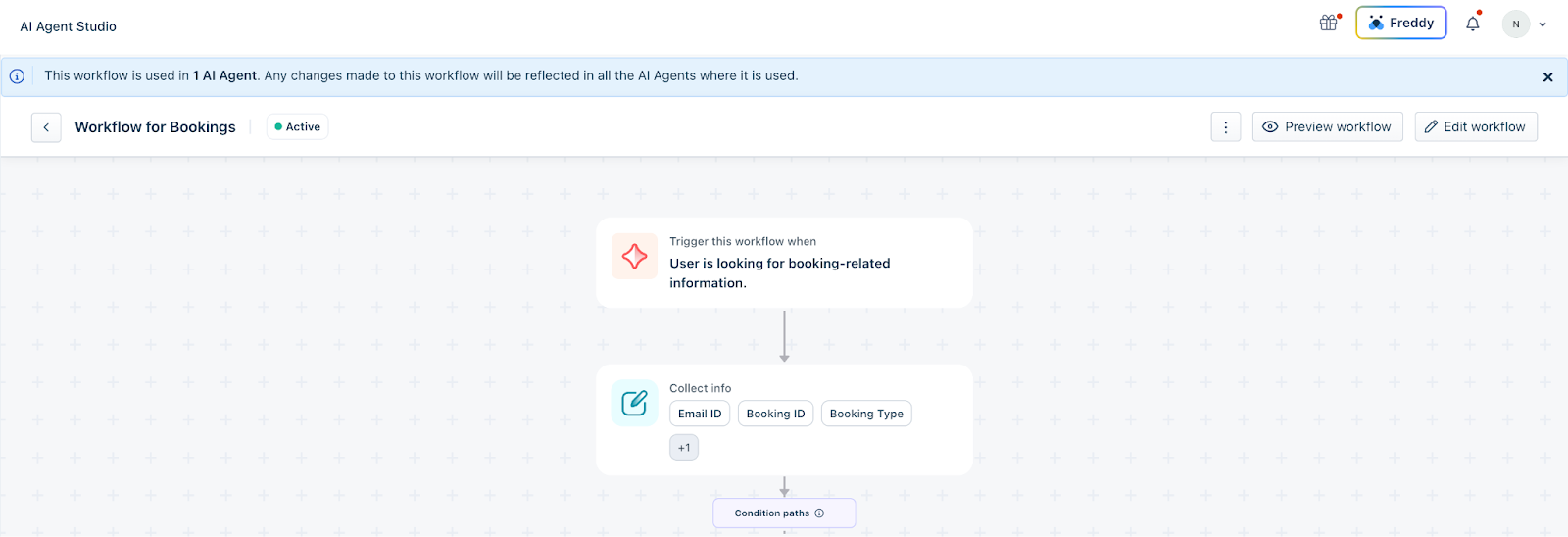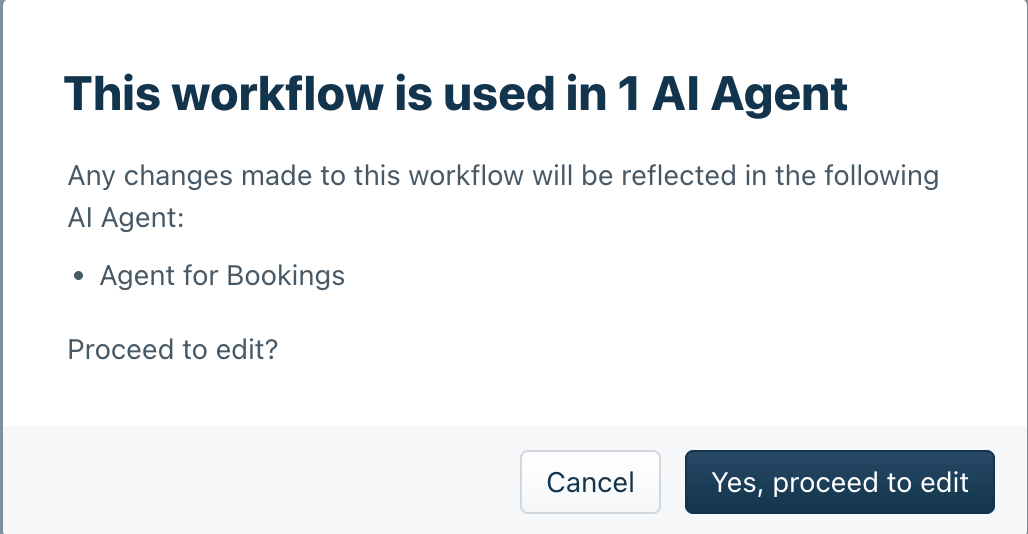The Workflow Library is a no-code interface that enables Admins to create Agentic Workflows for AI Agents without writing a single line of code. Each Workflow is built using modular blocks that define how the AI Agent should:
Collect information from users
Evaluate conditions
Take actions across different systems
Respond with the right information
Or hand off to a human Agent when needed
Here’s a breakdown of the six key blocks available in the builder:
Trigger Block
What it does:
This is the starting point of any Workflow. It defines when the AI Agent should initiate a Workflow, based on user input.
How to use:
Click the Trigger block to open a configuration panel where you can enter natural language instructions. This is where you define phrases or expressions customers might use to trigger the Workflow.
You can optionally include real-world examples and business-specific terms to make the AI Agent more effective. For instance, in an e-commerce domain, users may use terms like:
“Check RTO status” (Return to Origin)
“COD order issue” (Cash on Delivery)
“Where’s my tracking number?”
“Exchange window expired?”
Providing these domain-specific examples helps the AI better recognize customer intent and respond accurately—especially for industries with nuanced workflows or unique vocabulary.
Best Practice: Use varied, natural-sounding examples that your customers actually say.
Note: A common misconception is that the Trigger block can act on system events (like conversation initiation or positive/negative feedback) or detect sentiment. It cannot. The Trigger block only responds to customer queries.
Collect Info Block
What it does:
This block enables the AI Agent to ask for and store information from the customer in temporary Workflow-scoped variables.
How to use:
For each variable, use a simple prompt like:
“Ask the user for their 6-digit order ID”
“Collect the email linked to the subscription”
Along with the prompt, you can add a description to clarify what the property is about. For example: if the parameter is email address and the description is email address associated with the booking, the AI Agent will procure the email address used for booking.
You can then configure each variable as:
Mandatory – The AI must collect this before proceeding. It will keep prompting until the customer provides it.
Optional – The AI will try to collect it, but will move on even if the customer doesn’t respond.
There are four types of Collect Info:
Text - Collects free-form input such as names, addresses, or order IDs.
Number - Collects numeric input such as quantity, PIN codes, or ticket numbers.
List – If you define items in the description, the AI Agent will still treat the customer’s response as text input. The description simply helps guide the response, but won’t display as a selectable list.
Boolean – This will be rendered as plain text (not as a radio button or toggle).
Where it’s used later:
These collected variables can be used to:
Set conditions in a Condition Path
Fill fields in an API Action
Personalize messages in Custom Responses
Best Practice:
Keep questions concise and relevant
Make only essential fields mandatory to reduce friction
Use terms your customers are familiar with (e.g., “tracking ID” vs. “shipment reference”)
API Action Block
What it does:
This block connects your Workflow to external systems via APIs, so the AI can retrieve or send data.
Three parts to configuring this block:
1. Choose or Create API Action
Select an existing API action from the dropdown
Note: API actions you've used across all Workflows will be available here to choose from
Or, click Create new API action to configure a new one from scratch. Click here to learn more.
To create a new API:
Enter a name
Define input variables
Configure the API URL, headers, auth, and body
Test the response
Define output variables to store and reuse later
Note: Once created, API actions are reusable across multiple Workflows.
2. Map collected inputs to API parameters
Map your collected variables (e.g., order ID, email) to the corresponding API fields.
Under Advanced preferences, you can enable Ask for confirmation. When turned on, the AI will confirm with the customer before performing any sensitive action—like canceling an order or changing a plan.
Best Practice:
Always test your API action during setup. Use confirmation toggles for high-impact operations.
Condition Path Block
What it does:
This block allows the AI Agent to branch into different logic flows based on information collected or retrieved earlier.
You can:
Set multiple conditions (e.g., if order status is “shipped”)
Add an Else path as a fallback
Use outputs from the API or collected variables in your logic
For example, after showing order details, use a Condition Path to check:
Has the item shipped already?
Is the order eligible for expedited processing?
Based on the answers, the Workflow can continue with expedited handling or inform the user why it can’t proceed.
Best Practice:
Keep each path focused and purposeful
Add fallback paths for incomplete or unexpected responses
Custom Response Block
What it does:
This block allows you to manually define how the AI should respond to the customer.
You have two options to set up your responses:
AI-generated response - Use when the reply depends on customer inputs or fetched data (e.g., “Your flight from {origin} to {destination} departs at {time}”). Saves time and ensures dynamic accuracy.
Send your own response - Use when the reply must always stay the same (e.g., “Please contact support for booking changes”). Good for policies, disclaimers, or standard instructions.
Best Practice:
Use Custom Responses when tone, brand voice, or exact phrasing matters.
Agent Handoff Block
What it does:
This block transfers the conversation to a live human agent when needed.
This is useful in:
A workflow or specific condition requires handing the conversation over to agents
When AI can’t resolve the query
Best Practice:
Use this block at points of failure or uncertainty. Also, set expectations with a message like:
“I’m connecting you with a human agent who can help further.”
Workflows Versioning
Workflows versioning helps you make changes to existing Workflows quickly without having to disrupt or delete the active or live Workflow.
To make changes to an existing workflow,
On the Workflows list page, under Created Workflows tab, click on a Workflow you want to make changes to
Click Edit Workflow on the top right.
In the confirmation pop-up that discusses which AI Agents are using the Workflow, click 'Yes' and proceed to edit.
A draft of the active Workflow will be created, where you can make the changes required (for example: Changing a condition), ensuring the current active Workflow remains as-is
You can preview the changes you have made by clicking Preview Workflow at the top. Here you can test the Workflow to check if the changes you have made are now reflected.
Once the changes are made, click Make it active
In the confirmation pop-up that appears, click Yes, Make it active.
When you make a draft version active:
The draft version will replace the current active version in both the Workflows library and AI agents
The previous active version will be removed
If you have a draft version that you haven’t made active yet. You will see the active and draft versions in the Workflows list view.
Note:
Workflow versioning is applicable only to custom Workflows
Once the draft version is made active, all AI agents using the Workflow will use the new active version.






